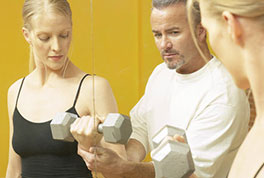|
|
||||||||||||||||
|
|
||||||||||||||||
|
|
Do's |
Don’ts |
|
Use general screening techniques that may consist of a health history and non-invasive fitness testing (e.g., strength, flexibility), etc.
|
Assess neurological manifestations and evaluate quality of movement. |
|
Design and implement fitness/ wellness programs that address the body as a whole. |
Make a diagnosis and prescribe a treatment-based program. This includes the collection of data for functional, financial, and other outcomes for independence restoration.
|
|
“Hands Off” policy is practiced by helping participants perform exercises independently. Touching participant is limited to spotting and guiding/cueing-example, “Lengthen the spine” as the instructor lightly runs fingertips up spine. After several verbal cues without response or modification from the student then a hands-on approach may be necessary to avoid injury.
|
“Hands On” approaches when client may need assistance to perform movement, such as facilitating or assisting with movement of limbs. |
|
Encourage student to self-transfer when able to do so. Should they need assistance, request that they bring a personal assistant to help. |
Unless certified and/or experienced in transferring skills do not attempt to transfer a student or allow other students in a class setting to assist. |
|
Provide an overall objective of physical well-being and achieving overall fitness goals.
|
Provide an overall objective that is on improving specific function(s) until a plateau or stable condition is reached. |
|
Provide group and one-on-one services. “Customers” are called students/participants (group setting) or clients (one-on-one setting). |
Provide one-on-one treatment service where “customers” are called patients. |
|
Stay within your realm of practice and expertise. While students may ask for advice around other lifestyle practices, referral to the appropriate professional for accurate advice should be made. |
Provide general information or prescriptive plan about topics outside the scope of expertise. |

 As fitness professionals you provide students the opportunity to learn about activities that focus on movement that can positively impact activities of daily living. Rehabilitation professionals focus on therapeutic services with goals that differ from those of general fitness instruction. As an instructor, remember to stay within your realm of practice, and be sure to recognize when to refer on to the appropriate health professional. Do not offer medical advice, even if you are a health professional by trade. You may share information and experience, but refrain from giving personal interpretations, giving advice, or offering specific treatment recommendations.
As fitness professionals you provide students the opportunity to learn about activities that focus on movement that can positively impact activities of daily living. Rehabilitation professionals focus on therapeutic services with goals that differ from those of general fitness instruction. As an instructor, remember to stay within your realm of practice, and be sure to recognize when to refer on to the appropriate health professional. Do not offer medical advice, even if you are a health professional by trade. You may share information and experience, but refrain from giving personal interpretations, giving advice, or offering specific treatment recommendations.